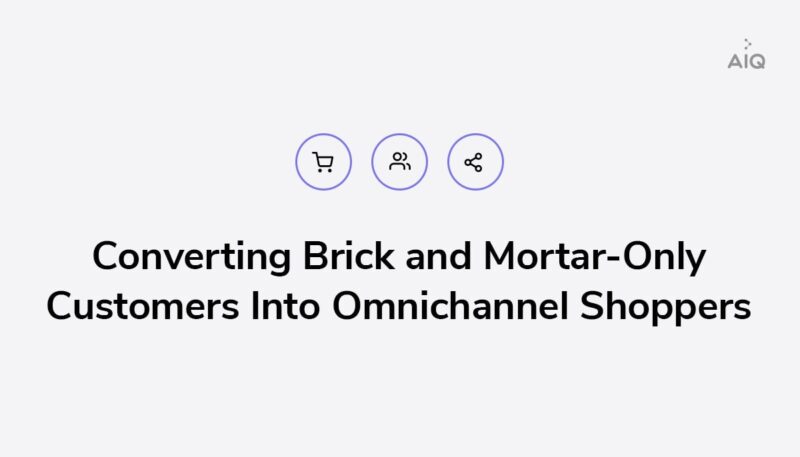Converting Brick and Mortar-Only Customers into Omnichannel Shoppers

In this blog, you’ll learn
-
How omnichannel retailing drives more revenue, margin and repeat purchases
-
Why certain shoppers opt for the brick and mortar customer experience
-
Techniques for migrating store-only shoppers to the digital channel
In the spring of 2020, the omnichannel retailer landscape saw an entire channel go down. Unlike the infamous holiday season, dot-com crashes shoppers experienced at the dawn of the ecommerce era, this channel outage had nothing to do with overloaded servers and bleeding-edge ecom systems brought to market too soon.
Rather, social distance protocols and concerns over Coronavirus contagion brought cash-and-carry brick and mortar operations to a halt for non-essential retailers, and greatly limited operations for essential retailers, where 60% of consumers are worried about shopping in-store.
Short Term Fix, Long Term Opportunity
With brick and mortar representing 84% of all retail sales in the U.S., that’s a nearly $3.2 Trillion segment of the American retail economy hobbled. Online shopping has an opportunity to fill the gap. As such, retailers are now in need of strategies and tactics to migrate physical store shoppers online increase customer satisfaction and meet customer expectations.
But like many strategies for persevering through the COVID-19 crisis and the new socially distanced economy, bringing offline consumers online already made good business sense.
Based on data from a range of ActionIQ’s CDP clients, customers who buy offline and in-store are significantly more profitable than single-channel shoppers:
-
Average annual spend is 2x that of other repeat buyers
-
Margins are 130% higher versus other repeat buyers
-
They are 50% more likely to keep shopping year after year
That’s why focusing on converting brick and mortar-only shoppers to an omnichannel approach make sense as both a near-term tactic, as well as a longer-term strategy for business health and growth.
Why Shoppers Choose Brick and Mortar
The dividing lines are not obviously generational.
Migrating shoppers from offline to online, however, is challenging. Each customer has their own reasons for choosing brick and mortar. For some, it’s a matter of habit. For others, it’s a preference to touch and try out items before purchasing, the ability to take them home immediately, or the perceived ease of returns for in-store purchases. And still, others may lack familiarity with an online shopping technology, or have difficulty accessing it.
The dividing lines are not obviously generational. 66 percent of baby boomers regularly make purchases online, and 82% of them are on social media—but prefer purchasing in-store because of the customer service experience. Millennials spend more time in front of computers and do more online shopping. But generation z is glued to its phone and uses it as a complement to in-store shopping, showing a preference for brick-and-mortar shopping that’s nearly 2:1 over online. The solution to bringing each constituency online with your brand—and the ease with which it can be done— isn’t one size fits all.
Cracking the Code to Migrating Customers
The key to building out a successful offline-to-online strategy begins with data about your customers, and the ability to segment and personalize the customer base utilizing that data. Then you need the agility to develop, test, and iterate messages and tactics for bringing those customers online, per segment.
With its unified customer behavior data and the ability to manage a personalized experience across all channels, your customer data platform (CDP) is an ideal place to build and refine your offline to online techniques.
Identifying Likely Converts
Start out by focusing on your offline customers who are most likely to convert into digital or multichannel shoppers. Here are some basic indicators of offline-first or offline-only shoppers who are more likely to become multichannel shoppers:
- Have visited your brand’s website recently
- Have opted into email
- Are following your brand on social
- Are in clienteling / have phone relationship with a store associate
- Have purchased or communicated via the contact center
- Are active in the direct mail database
By analyzing the basic indicators above alongside purchase and engagement data, you can begin to develop segments to prioritize and target campaigns.
Leveraging AI and ML
Your CDP’s AI and machine learning capabilities can also be leveraged to more efficiently identify customers most likely to become online shoppers. One technique, known as lookalike modeling, can be especially powerful—and inasmuch as the recent brick and mortar shutdown has been challenging, it also provides a unique opportunity for analysis.
By looking at customers who were brick-and-mortar exclusive prior to social distancing, yet seamlessly made the transition to online shopping, you can identify customers with similar pre-shutdown shopping behavior who haven’t yet made the jump to online. These “lookalikes” can yield improved offline to online conversion campaign results.
Honing the ‘Multichannel Experience’ Message
Your message and mode of outreach are also critical in attempting to convert offline shoppers to online. As a baseline, you’ll want to convey the convenience and seamless experience of online shopping as well as the ease of returns. Personalizing your messages based on the customer’s in-store shopping history will increase the relevance of your messages and improve response rates. Testing and iteratively refining your messages is critical.
Optimizing Engagement Channels
The channel you utilize to reach out to customers also matters. By all means, test the efficacy of email and leverage multiple touchpoints where effective—but given these are offline customers, it will not succeed everywhere.
If your associates have a clienteling relationship with customers, or if you operate with an assisted sale in-store model, leverage those relationships to reach out directly. Some retailers are enabling associates with videoconferencing capabilities where they are providing customers personalized tours of the online store, hosting virtual shopping parties, and guiding them through completing their first online orders.
If your associates have a clienteling relationship with customers… leverage those relationships to reach out directly.
Social media is also an excellent avenue for bringing the store to your customers and helping them make the jump from offline to online utilizing a mix of tactics including educational content, community, and digital advertising. (Recall from above that 82% of boomers are on social media.)
CUSTOMER SPOTLIGHT
Major Apparel & Accessories Retailer
A well known apparel and accessories brand with nationwide stores, wholesale operations, and a significant online ecommerce presence, sought to maintain connections with store-only customers after the physical retail channel went down. Failure to re-engage store-only customers online would cost them millions in lost net margin dollars annually.
The retailer used ActionIQ CDP’s lookalike modeling capability to target the brick and mortar-only customers most likely to become online shoppers. They then defined multiple segments for iteratively testing various digital customer engagement campaigns.
After two weeks of testing an omnichannel strategy, the retailer saw these results thanks to the implementation of an omnichannel experience for customers:
-20%
drop in CAC versus previous approaches to migrating customers online
$3MM
in projected annual margin preservation
+10%
increase in purchasing rate versus the control group of store-only customers
Having completed a successful test, the brand plans to scale the campaigns out to larger audiences while continuously monitoring performance to deepen its understanding of who is responding to their efforts, and to look for additional opportunities to create a relevant digital experience for their customers with the help of data and intelligence
Testing, Iterating, and Leaning on Your CDP
Migrating offline customers to omnichannel customers isn’t a flip of the switch. It takes a persistent effort, and the agility to test and iterate different marketing messages and tactics across your retail experience for customers. But the results are worth it. And if you employ a state-of-the-art CDP with what Gartner calls a smart hub architecture, you’ll have the ability to rapidly automate everything from lookalike modeling and personalization to testing and measurement. You can quickly:
- Unify online and offline behavioral data from across disconnected marketing systems
- Provide self-service access to that data, so marketers can identify opportunities
- Identify targets with predictive intelligence
- Optimize personalized execution across channels
- Support short-term and long-term KPI measures and incrementality assessment
- Launch Your Offline to an Omnichannel Retail Strategy
The ActionIQ team and our industry-leading CDP have helped dozens of brands convert more offline shoppers into omnichannel retail customers. If you’re looking to do the same with your shopping experience, we’re ready to help. Contact us today for a complimentary consultation with one of our experts.





